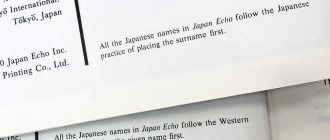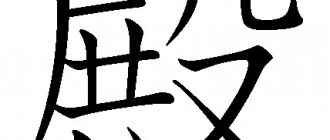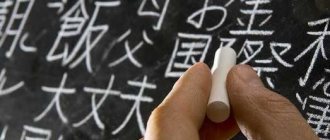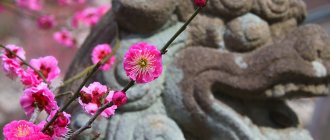Nominal suffix 殿 (どの, dono)
This very old nominal suffix is the predecessor of the suffixes we know today, such as さん (san), 君 (くん,kun), or ちゃん (chan). The suffix 殿 (どの, dono) was used to denote well-fed, portly gentlemen, literally “those with large buttocks” (this may sound strange, but it is true).
Here's how it happened: the character 殿 (どの) comes from the character 臀 (しり, shiri), which means “buttocks.” If you have large buttocks, you sit on them with stability and confidence. Therefore, the character 殿 has an indirect reference to a large strong house. Why? Because a big strong house is stable and strong, just like a heavy-set person.
Going back to those days, let's think about who could reside in large, rich houses such as palaces, sanctuaries or temples? Of course, these are people from privileged classes, high-ranking members of society.
We are approaching the end. In Japan it was considered rude to be too direct. So, calling a person from a privileged class by name was already rude. Thus, people began to call them family estates to soften the appeal. For example, not Tanaka, but coming from Tanaka's house.
Over time, the suffix 殿 came to be used to refer to government officials, such as the emperor's chief advisor, for example. At first, the honorific was used mainly in writing, but people began to use it in spoken language. Eventually, the suffix 殿 began to be used by ordinary people, and this reduced the amount of respect it was given.
The Japanese language needed a new word to take the place of 殿 and carry the same meaning, and so the nominal suffix 様 (さま, sama) was born.
Nominal suffixes in Japanese. How the suffix 殿 (どの) is used in everyday life
As you have seen, the suffix 殿 has undergone many changes. Even though this is an incredibly old call, it still exists. Here are some usage points:
- Typically 殿 is used in writing rather than spoken language.
- 殿 is usually used after a full name.
- Sometimes the suffix 殿 is used after a position (without indicating the person's last name), for example 部長殿 (ぶちょうどの, buchodono, respected director).
- In business/official documents, 殿 may sometimes be used instead of 様 (さま, sama), although the suffix 様 is more common. More and more companies and government organizations are using 様.
- However, citizens can still use the suffix 殿 when writing a letter to a government agency.
- In situations where 殿 would be used in writing, in colloquial speech it is replaced with the suffixes 様(さま, sama) or さん(san).
- The suffix 殿 is used as an address, usually in certificates and diplomas. When an award ceremony or diploma issuance takes place, the person’s name is read out with the suffix 殿, without replacing it with 様.
- 殿 can be used in a sarcastic context when someone is being arrogant.
Nominal suffixes
In the Japanese language, there is a whole set of so-called nominal suffixes, that is, suffixes added in colloquial speech to first names, surnames, nicknames and other words denoting an interlocutor or a third party. They are used to indicate the social relationship between the speaker and the one being spoken about.
The choice of suffix is determined by the character of the speaker (normal, rude, very polite), their attitude towards the listener (common politeness, respect, ingratiation, rudeness, arrogance), their position in society and the situation in which the conversation takes place (one-on-one, in a circle of loved ones friends, between colleagues, between strangers, in public).
What follows is a list of some of these suffixes (in order of increasing "respectfulness") and their common meanings.
-chan (chan) - A close analogue of the “diminutive” suffixes of the Russian language. Usually used in relation to a junior or inferior in a social sense, with whom a close relationship develops. There is an element of baby talk in the use of this suffix. Typically used when adults address children, boys address their girlfriends, girlfriends address each other, and small children address each other. The use of this suffix in relation to people who are not very close, equal in status to the speaker, is impolite. Let's say, if a guy addresses a girl his age in this way, with whom he is not “having an affair,” then he is being inappropriate. A girl who addresses a guy of her own age in this way, with whom she is not “having an affair,” is essentially being rude.
-kun (kun) - An analogue of the address “comrade”. Most often used between men or in relation to guys. Indicates, rather, a certain “officiality” of, nevertheless, close relationships. Let's say, between classmates, partners or friends. It can also be used in relation to juniors or inferior in a social sense, when there is no need to focus on this circumstance.
-yan (yan) - Kansai analogue of “-chan” and “-kun”.
-pyon (pyon) - Children's version of "-kun".
-tti (cchi) - Children's version of "-chan" (cf. "Tamagotti").
-without a suffix - Close relationships, but without “lisping.” The usual address of adults to teenage children, friends to each other, etc. If a person does not use suffixes at all, then this is a clear indicator of rudeness. Calling by last name without a suffix is a sign of familiar, but “detached” relationships (a typical example is the relationship of schoolchildren or students).
See also: Very interesting facts about Japanese schools
-san (san) - An analogue of the Russian “Mr./Madam”. A general indication of respect. Often used to communicate with strangers, or when all other suffixes are inappropriate. Used in relation to elders, including older relatives (brothers, sisters, parents).
-han (han) - Kansai equivalent of “-san”.
-si (shi) - “Mr,” used exclusively in official documents after the surname.
-fujin - “Mistress”, used exclusively in official documents after the surname.
-kohai (kouhai) - Appeal to the younger. Especially often - at school in relation to those who are younger than the speaker.
-senpai (senpai) - Appeal to an elder. Especially often - at school in relation to those who are older than the speaker.
-dono (dono) - Rare suffix. Respectful address to an equal or superior, but slightly different in position. Currently considered obsolete and practically not found in communication. In ancient times, it was actively used when samurai addressed each other.
-sensei - “Teacher”. Used to refer to teachers and lecturers themselves, as well as doctors and politicians.
-senshu (senshu) - “Sportsman.” Used to refer to famous athletes.
-zeki (zeki) - “Sumo wrestler.” Used to refer to famous sumo wrestlers.
-ue (ue) - “Elder”. A rare and outdated respectful suffix used for older family members. Not used with names - only with designations of position in the family (“father”, “mother”, “brother”).
-sama (sama) - The highest degree of respect. Appeal to gods and spirits, to spiritual authorities, girls to lovers, servants to noble masters, etc. Roughly translated into Russian as “respected, dear, venerable.”
-dzin (jin) - “One of.” "Saya-jin" means "one of Saya."
-tachi (tachi) - “And friends.” "Goku-tachi" - "Goku and his friends."
See also: How to “translate” Korean names from Latin to Cyrillic
-gumi (gumi) - “Team, group, party.” "Kenshin-gumi" - "Team Kenshin".
Personal pronouns
In addition to nominal suffixes, Japan also uses many different ways to address each other and refer to themselves using personal pronouns. The choice of pronoun is determined by the social laws already mentioned above. The following is a list of some of these pronouns.
Group with the meaning "I"
Watashi - Polite option. Recommended for use by foreigners. Typically used by men. Infrequently used in colloquial speech, as it carries a connotation of "high style".
Atashi - Polite option. Recommended for use by foreigners. Typically used by women. Or gays. ^_^ Not used when communicating with high-ranking individuals.
Watakushi - A very polite female version.
Washi - An outdated polite option. Doesn't depend on gender.
Wai - Kansai equivalent of washi.
Boku (Boku) - Familiar youth male version. Rarely used by women, in this case “unfemininity” is emphasized. Used in poetry.
Ore - Not a very polite option. Purely masculine. Like, cool. ^_^
Ore-sama - "Great Self". A rare form, an extreme degree of boasting.
Daiko or Naiko (Daikou/Naikou) - Similar to “ore-sama”, but somewhat less boastful.
Sessha - Very polite form. Typically used by samurai when addressing their masters.
Hishou - “Insignificant.” A very polite form, now practically not used.
Gusei - Similar to hisho, but somewhat less derogatory.
Oira - Polite form. Typically used by monks.
Chin - A special form that only the emperor has the right to use.
Ware - Polite (formal) form, translated as “[I/you/he] myself.” Used when the importance of “I” needs to be particularly expressed. Let's say in spells (“I conjure”). In modern Japanese it is rarely used to mean "I". It is more often used to form a reflexive form, for example, “forgetting about oneself” - “vare in vasurete.”
[Speaker's name or position] - Used by or when communicating with children, usually within the family. Let's say a girl named Atsuko might say "Atsuko is thirsty." Or her older brother, addressing her, may say, “Brother will bring you juice.” There is an element of “lisping” in this, but such treatment is quite acceptable.
See also: Transcription of Russian proper names into Chinese
Group meaning “We”
Watashi-tachi - Polite option.
Ware-ware - Very polite, formal option.
Bokura - Impolite option.
Touhou - Regular option.
Group with the meaning “You/You”:
Anata - General polite option. It is also common for a wife to address her husband (“dear”).
Anta - Less polite option. Typically used by young people. A slight hint of disrespect.
Otaku - Literally translated as "Your home." A very polite and rare form. Due to the ironic use by Japanese informals in relation to each other, the second meaning was fixed - “feng, crazy.”
Kimi - Polite option, often between friends. Used in poetry.
Kijou - “Mistress”. A very polite form of addressing a lady.
Onushi - “Insignificant.” An outdated form of polite speech.
Omae - Familiar (when addressing an enemy - offensive) option. Usually used by men in relation to a socially younger person (father to daughter, say).
Temae/Temee (Temae/Temee) - Insulting male version. Usually in relation to the enemy. Something like “bastard” or “bastard.”
Honore (Onore) - Insulting option.
Kisama - A very offensive option. Translated with dots. ^_^ Oddly enough, it literally translates as “noble master.”
If you find an error, please select a piece of text and press Ctrl+Enter.
Nominal suffix 様(さま, sama)
When the suffix 殿(どの) became too common, a new word was needed to express the nobility of the one being addressed. Thus, during the Muromachi period (1336-1573), if you wanted to avoid referring to some gentleman by name, you used the suffix 様 (さま).The character 様 was originally written differently, and it was used when one wanted to talk about someone indirectly. At that time, 様 meant “somewhere out there,” so it was more like talking about a location, not about a specific person.
But, as with 殿, people started using 様 as a noun suffix. And if adding 殿 was a polite form of address, such as “Tanaka house,” then 様 was an even more polite form. Instead of calling someone "Tanaka house", they called it "around Tanaka house".
To show the actual use of this suffix at that time, here are some examples. Thus, the emperor who lived in the imperial palace was addressed as 御所様 (ごしょさま, goshosama) or 大御所様(たいごしょさま, taigoshosama). And the daimyo (class of feudal samurai) who lived in 屋形号 (やかたごう, yakatagou) was called 屋形様 (やかたさま, yakatasama).
How honorable was the new nominal suffix 様? Portuguese books on Japanese grammar written during the Edo period (1603-1868) highlight four politeness suffixes used at that time: 殿(どの, dono), 様(さま, sama), 公 (きみ, kimi), and 老(ろう, rou). The most honorable suffix was 様, not 殿. This was the result of the 殿 suffix being used by common people. He immediately lost his significance.
The suffix 様 had different ways of writing, depending on what degree of politeness the speaker wanted to convey. The image below shows variations of its spelling.
In those days, when writing a letter to someone, the character 様 was written in such a way as to take into account the relationship between the people in the correspondence. As you can see in the image, the character 様 is written in eight different ways, and each subsequent spelling is a little rougher and more sketchy. So, when addressing someone in correspondence, you wrote the character 様 in a way that expresses the degree of your closeness to the person. The following will give different names for the suffix 様 depending on its spelling and examples of its use.
- 永様 (えいざま/えいさま, eizama/eisama) : Written in kaisho (standard style), printed handwriting. Writing in this style turns the lower right radical into 永, which is the obsolete/original way of writing the character 様. Very respectful address. This writing method is used when the recipient of the letter is of higher status than the one writing the letter.
- 永様 (えいざま/えいさま, eizama/eisama) : A method similar to the above, but less elaborate and clear, which therefore expresses less respect.
- 次様 (つぎざま/つぎさま, tsugizama/tsugisama) : The lower right radical 永 becomes 次. This treatment is used to refer to people who are slightly higher in social status or to equals.
- 美様 (びざま, hizama) : The right side of the character 様 is written as 美 in sosho style (i.e. italic, cursive). This way of writing is similar to the previous one (次様), but a little less respectful.
- 平様 (ひらざま, hirazama) : This writing method is fragmented, unlike those listed above, it was intended for communication with equals or with those of lower social status.
- 平様 (ひらざま, hirazama) : The writing method becomes a little more deformed, and thus the recipient is given a little less respect.
- 平様 (ひらざま, hirazama) : Another way of writing 平様 (ひらざま, hirazama), even more deformed and, accordingly, even less polite.
- 蹲様 (つくばいざま, tsukubaizama) : Using this method of address was quite rude. The name 蹲様 (つくばいざま) means that the person being addressed “lies on his hands and knees” while making a humiliating bow called 土下座 (どげざ, dogeza).
There are also two more types of writing the address 様, which were not shown in the figure, but which are relevant for our time:
- 水様 (みずざま/みずさま, mizuzama/mizusama) : This is the same 様 that we use today. In earlier times it was used to refer to people of lower social status.
- さま/サマ(sama) : you can write a message to your friend using 様 kana. But remember, 様 written in alphabet does not express respect, so in more formal situations, use the hieroglyphic spelling.
Japanese nominal suffixes. How 様(さま, sama) is used in everyday life
Although 様 is a very respectful form of address and it may seem like something you would never use, there are times when it is appropriate. Here are some examples of when to address a person with the honorific suffix 様:
- Usually this nominal suffix is used after the full name or after the surname
- Hospital name signs may be written 様, but the more common suffix is 殿.
- In the media, they use the 様 suffix when talking about members of the imperial family, even if they are talking about a child.
- In electronic correspondence when contacting clients, customers or superiors.
- It is incorrect to use the 様 suffix after a position, but it is possible to use the 様 suffix after a position followed by a name. For example: 部長のコウイチ様(ぶちょうのコウイチさま, butyou no koiti-sama) “department head Koichi.”
Interesting Facts:
- Organizations such as the Japanese Communist Party, which believes that all people are equal, do not use the suffix 様 even when talking about the emperor.
- National organizations and the imperial family do not use the 様 suffix when referring to the emperor. Instead, they use 陛下(へいか, heika) “His Majesty” or 殿下(でんか, denka) “His Highness.”
Pronouns in Japanese 2nd person
あなた (anata) translates to “You” and is a singular pronoun. The plural is あなたたち (anatatachi), or, if we want to sound more polite, then あなたがた (anatagata). The word あなた (anata) should not be used too often in speech. Strictly speaking, it is appropriate to use it only when you do not know the name of your interlocutor. In other cases, instead of あなた (anata), they usually use the surname or first name of the interlocutor plus an address suffix, for example: 田中さん (Tanaka-san). Yes, it sounds a little strange if translated into Russian literally. 田中さんはどこに住んでいますか。(Tanaka-san wa doko ni sunde imasu ka.) – “Where does Tanaka live?” (and we ask this directly from Tanaka, as if calling him in the 3rd person). Literally, this can be translated as “Tanaka, where do you live?” And the Japanese use this turn of phrase much more often, which is あなた (anata).
Anata no namae wa nan desu ka.
What is your name?
Yamada-san wa koko ni yoku kimasu ka.
Yamada, do you come here often?
Also, the word あなた (anata) is what a Japanese wife usually uses to address her husband. In this case, it can be translated as “you” or “dear”.
There is also a shortened form あんた (anta), which is more common in colloquial speech.
"You" in Japanese is 君 (kimi). This pronoun is used much more often by men, usually in relation to girls or inferiors. 君 (kimi) is often used by superiors in relation to subordinates. Women use this pronoun much less often. The same rule applies here: usually the Japanese do not say “you” or “you”, but call the interlocutor by first or last name. The plural form of this pronoun is 君たち (kimitachi) - “you”.
君を守りたい。Kimi wo mamoritai.
I want to protect you.
There are also ruder ways to say "you" in Japanese. Firstly, it is お前 (omae). This is what we say to a person we don’t really respect. Men often resort to this pronoun. The plural form of this pronoun is お前ら (omaera).
And a very rude way to say “you” would be 貴様 (kisama). It is interesting that initially this was a very polite address used in the court environment. But over time, on the contrary, it became abusive. Agree, when we are angry with someone, we can also resort to a similar stylistic turn, something like: “maybe Your Majesty should iron some more shoelaces?!” 貴様 (kisama) is even harsher than お前 (omae), so if you are not going to challenge your interlocutor to a mortal fight, you should not say it.
Another swear word for “you” is てめえ (temee). It can also often be heard in anime when a hero challenges an opponent or when he is very angry with his interlocutor.
By analogy with こちら (kochira), which means “we, our side,” in business communication the word そちら (sochira) is used to mean “you, your side.”
Sochira no tsugou no ii jikan wo ochiete kudasaimasen ka.
Could you tell me what time is convenient for you?
Thus, depending on the 2nd person pronoun that we choose, we can show either our respectful attitude towards the interlocutor (I repeat, the most successful way is to use not “you” or “you” as address, but the name of the interlocutor), or complete disregard, as in the case of お前 (omae) and 貴様 (kisama).
Nominal suffix さん(san)
Eventually, the noble, honorable nominal suffix 様 fell into the hands of the common people. But unlike 殿, which lost its status as number one, 様 remained intact because, once in common use, it became the suffix さん(san), losing the vowel あ at the end.
That's the whole story of the origin of the most famous nominal suffix.
Japanese nominal suffixes. How is さん used in everyday life?
The nominal suffix さん is universal. It can be used on men and women, young and old, for everyone. You'll need to use this call quite often, but to make sure you use it correctly, try to follow these rules:
- さん is used for both men and women, but at school さん is spoken mainly for girls, while for boys the suffix くん is used.
- Don't use さん (or any other nominal suffix) when talking about yourself.
- Use さん when communicating with strangers or someone with whom you are not in a close relationship.
- さん can be used to show respect to someone who has a higher status than you.
- Usually the suffix さん is used after the last name, but if you know the person well enough, you can use the suffix さん after the given name. But make sure the person considers your relationship as close as you do.
- Meanwhile, it is common for Japanese to add the suffix さん after the name when talking about foreigners, because most Japanese know that unlike Japan, where a person is called by his last name, in other countries it is common to call a person by his given name.
- Some people add the suffix さん when talking about companies, groups, and teams. This is to be polite when talking to someone who works for this company.
- The suffix さん is used to refer to family members, especially to elders, for example: お父さん (おとうさん, otousan) “father”, お母さん (おかあさん, okaasan) “mother”, お姉さん (おねえさん, oneesan) “elder sister”, etc. . Previously, the suffix 様 was used in these cases, but now the address お母様(おかあさま, okaasama) sounds archaic.
- Recently, some young people have been calling theirs not 赤ちゃん(あかちゃん, akachyan) “baby”, but 赤さん (あかさん, aka-san), because it sounds funny.
- It is also a common custom to add the suffix さん to animal names, especially when talking to children.
- Similarly, you can add the suffix さん to the names of inanimate objects, such as 冷蔵庫さん (れいぞうこさん, reizooko-san) “Mr. Fridge” or おいもさん (oimo-san) “Mrs. Potato”. It sounds polite, sweet, and kids love it.
- Many professions end with the suffix さん, such as 本屋さん (ほんやさん, hon'ya-san) “bookseller.”
1st person pronouns
Let's start with 1st person pronouns. Japanese has more of them than other languages. This is due to the fact that there are pronouns that are used only by men or, conversely, only by women, and pronouns can also differ in the degree of politeness.
私 (watashi) is a universal pronoun for the 1st person. It can be used by both men and women. Sometimes the same pronoun is pronounced as わたくし (watakushi) - this form is used when they want to sound more polite, mainly in formal settings, as well as when meeting for the first time. There is also a female version, which sounds like あたし (atashi), it is used only by girls, girls, and it sounds a little childish.
There are quite a few ways to form the plural of personal pronouns. All of them are built on the addition of various plural suffixes at the end of a word. Suffixes can be: がた (gata), たち (tachi), ら (ra).
To form the plural of the pronoun 私 (watashi), use the suffix たち (tachi). The resulting word is 私たち (watashitachi), “we.” This word is also universal in its use.
私は学生です。Watashi wa gakusei desu.
I am a student.
私たちはこの家に住んでいます。Watashitachi wa kono ie ni sunde imasu.
We live in this house.
Men can also use 僕 (boku) about themselves if they want to sound modest, and 俺 (ore) in a more casual, friendly environment. 俺 (ore) should not be used when communicating with superiors; it is mainly used when communicating with friends, family, equals or lower social status. When communicating with superiors, it is more appropriate to say 僕 (boku) - it is no coincidence that one of the meanings of this character is servant. The speaker thus emphasizes that he is below the interlocutor. The plurals of these are 僕ら (bokura) and 俺ら (orera), respectively. These pronouns are used mainly by men, although there are cases when girls also refer to themselves as 僕 (boku), but this is slang and rather the exception to the rule.
Boku wa kono kaisha ni tsutomete orimasu.
I work for this company. (Very polite).
俺ら、腹減ったぞ。Orera, hara hetta zo.
We're hungry. (Colloquial).
If we talk about female pronouns of the 1st person, then it is also worth mentioning the word うち (uchi). This pronoun is not used as often in Tokyo, but is more common in the Kansai region. The word うち (uchi) itself can be translated as “house, inside, ours.” It has no plural form.
Young children often use their own name instead of first person pronouns. For example:
健太は遊びに行きたいよ。Kenta wa asobi ni ikitai yo.
Kenta wants to go play.
我々 (wareware) – “we”, a pronoun used by the heads of organizations and the military. This is “we”, which emphasizes that a person speaks as a representative, a leader of a community.
Ware-ware wa uchuujin da.
We are aliens.
In addition, older people may use わし silently. To be honest, I have never heard this from modern Japanese, but it often occurs in anime and historical dramas.
If there is communication between two companies, then we will denote ourselves, our side, our company with the word こちら (kochira). For example:
こちらから連絡いたします。Kochira kara renraku itashimasu.
We (from our side) will contact you.
Another thing to consider is that the Japanese often omit first person pronouns. This is a little unusual. For example, when talking about ourselves, we will say this: “My name is Anya. I am 23 years old. I live in Moscow. I study at University…". Every sentence includes “I” or “me, me.” If we say the same thing in Japanese, we will use 私 (watashi) only in the first sentence, and in subsequent sentences we will omit this word.
Nominal suffix ちゃん (chan)
The exact origin of the suffix ちゃん(chan) is unknown, but a popular version is that ちゃん is the suffix さん distorted in children's speech. There is logic to this. When there is a word that everyone knows, children try to repeat it, but they cannot always pronounce it correctly. In Japan, children have trouble pronouncing the sounds さしすせそ/たちつてと(sa shi su se so/ta chi tsu te to), and unwittingly transform them into しゃししゅしぇしょ/ちゃちちゅちぇちょ(sha shi shu sye sho/cha chi chu che cho). So さ becomes ちゃ and suddenly we have a suffix to name children and small and cute things.
Japanese nominal suffixes. How is ちゃん used in everyday life?
We are on shaky ground, be careful with this suffix. You can't use it with everyone. This suffix is a term of endearment between family members, close friends, lovers, and is also used for pets. Use with caution!
- The suffix ちゃん is never used to refer to someone who is senior to you in position. Would you call your boss “sweetie”? Make sure you know the person really well before adding the suffix ちゃん to their name.
- The suffix ちゃん is common in family relationships. You can often hear children call their grandparents おじいちゃん (ojiichyan) and おばあちゃん (obaachyan), and their brothers and sisters おにいちゃん (oniichyan) and おねえちゃん (oneechyan). Sometimes they call mom and dad おかあちゃん (okaachyan) and おとうちゃん (otouchyan), but this is less common.
- The suffix ちゃん is usually attached to the given name rather than the surname. Sometimes the name is shortened to make it sound even sweeter, so コウイチちゃん (kouiti chyan, Koichi-chan) becomes コウちゃん (kou chyan, Ko-chan).
- If you use this suffix with a surname, it will be equivalent to a nickname in Russian. Example: 森ちゃん (もりちゃん, mori-chyan, Mori-chan)
- Typically, this suffix is used to refer to girls rather than boys, but can also be used to refer to boys (especially in childhood).
- People from the Kansai region, especially in Osaka, add the suffix ちゃん to everything. あめちゃん (ame-chyan) “Miss little candy”, イモちゃん (imo-chyan) “Miss little potato”, etc.
- In fact, there is nothing wrong with adding the suffix ちゃん to your own name. If other people give you a nickname with the suffix ちゃん, you can refer to yourself in the third person among them.
LiveInternetLiveInternet
Dono (殿, どの) - "lord" or "master", can be heard in historical films and anime. They are practically not used in everyday communication, but are sometimes used in business correspondence, certificates, awards, and written invitations to tea ceremonies. Dono is close in meaning to sama, but is less formal and often carries a connotation of affection, love for the interlocutor, and also serves to address, with great respect, a strong or important character to an equally strong interlocutor.
San (三、3 ,さん) —
A respectful prefix when addressing an interlocutor after a name or profession.
Almost never used when communicating within the family. As a simple, irreverent suffix, in everyday speech, -san
can be added to the names of animals and even food items.
This use is frivolous, childish and used by women and children (for example, a pet rabbit can be called “usagi-san” - “Mr. Rabbit”, or a fish in the kitchen - “sakana-san”). In western Japan (particularly Kyoto Prefecture),
はん
(han)
is used -san
Minna-san
(
皆三
) – referring to the plural of persons of both sexes.
Chan (ちゃん)
-
Diminutive suffix, in the words
猫ちゃん
(nekochan - kitten, or cat from
猫
(neko - cat),
赤ちゃん
(akachan - baby). Used in address after the name with children and women within the family. Can also be used by towards animals, lovers, close friends, and people you have known since childhood. -chan is used to express endearment towards adults, especially girls. -chan is used mainly by women towards women (some young women use -chan to of their name in the 3rd person). Men use -chan between very close friends or business partners or in relation to young boys. Also, chan is used for the nicknames of favorite performers, movie stars.
Sama (様,
さま) -
Used to address gods - Kami-sama, emperors, or people and objects to whom deep respect must be expressed - O-kyaku-sama (client, buyer) or Tateishi-sama (gem revered as divine). Also, the Japanese often add -sama to the names of people who have special skills, talent, or are particularly attractive (can sometimes be used ironically). Using -sama with one's own name or the pronoun "I" (ore-sama) is considered selfish and arrogant. It is added to names on postcards, letters, parcels, and business emails. There are two additional variants - sama: Tyama (chama) is a hybrid word made up of the parts chan and sama, used to refer to a younger interlocutor who deserves more respect than is due by age; Tama is a softer form of -sama, used rarely, mainly by young children in relation to older brothers, sisters or older friends who are an authority for them (“O-nii-tama” - “elder brother”).
Kun (君,
くん)
Used when addressing a senior to a younger one, between men of approximately the same age and position, when addressing a male child and, sometimes, a male pet.
Also used by women when mentioning men for whom they have feelings (in a diminutive manner). Failure to use the suffix -kun
, in most situations, can be regarded as impolite, disrespectful, rude treatment (just like
-san
,
-kun
is not used when addressing one’s own child within the family.
Sho-kun
(
諸君
) – addressing a plural number of persons, predominantly male.
Senpai (先輩, せんぱい)
- “comrade standing behind” is used to address a more senior colleague (by experience, age) within an organization, for example, at a school to an older student.
Can be used for one's own name or the name of an interlocutor, instead of -san
.
Ko ′ hai
(後輩, こうはい) -
a rude address to a more junior colleague, is practically not used when addressing a younger colleague directly; instead, the address
-
kun is used. According to the unwritten rules that exist in Japanese society, the kohai must treat the sempai with respect, fulfill his minor requests and instructions, and the sempai looks after the kohai and is responsible for him to the official leadership of the organization. Quite often, senpais abuse their position, and kohai are infringed upon in their rights, for example, in sports clubs, beginners are sometimes not even allowed to attend training, and their main occupation is helping elders, maintaining sports equipment, and cleaning the premises after training. Despite this, the system of senpai/kohai relations brings certain benefits, making the work of official management easier, and, in the absence of excesses, allows newcomers to quickly adapt to a new environment and learn useful experience from their older comrades. Often a kohai does not end his friendship with his senpai even after completing his training or leaving the club.
Sensei (先生,
せんせい) -
Used to address teachers, doctors, lawyers, lawyers, politicians, representatives of creative and other socially important professions. Expresses respect for a person who has achieved certain knowledge and mastery in the profession. Sensei can also be used in a sarcastic sense to refer to "inflated", self-confident stars, politicians, and religious figures with undeserved delusions of grandeur.
Shi-(O) (氏(お) ,
し(お) ) –
When addressing a lord, for example
わが氏お
(waga shi-o) – My lord. It is also used in official documents, letters and in formal speech towards strangers (for example, in the news). When a person is mentioned for the first time in a conversation, his name and the suffix -shi- are indicated. Further in the conversation, instead of the full name, only si is used.
Ue (上, うえ) “higher” - expresses a high level of respect for the interlocutor. Rarely used in ordinary speech, it is included in established expressions: chichi-ue (父上) and haha-ue (母上) - a respectful mention of someone's parents, including one's own. When used, it does not require a name and is often used in conjunction with ue-sama.
Both women and men predominantly use the word oto:san when addressing their father.
When addressing a man's older siblings, the words aniki (respected) elder brother and aneki (respected) elder sister are used.
One phrase in Russian can be said in several Japanese, they differ in the degree of education and male or female speech.
For example, the phrase: My name is Tamako/Yujiro.
It will sound rude, familiar, or in a close circle -
あたしの名は珠子です(
or
だよ)
(atashi no na wa Tamako desu (or da yo)) – the girl would say.
おれ(
or
わし)の名はゆうじろだ
(ore (or yours) but na wa Yujiro yes) – the guy would say
Neutral polite -
私(僕)の名前は珠子(ゆうじろ)とおっしゃいます
(watashi (boku, if a guy, although you can both say watashi) but namae wa Tamako (Yujiro) then osshaimasu)
Very polite and formal -
珠子と申します
(Tamako to mo◜shimasu)
Many verbs that mean the same word sound different for the same reason.
For example, the question: Do you know anything?
Familiarly -
(temae wa nanika shitte no ka?)
Politely –何かご存じるですか
(nanika go dzonjiru des ka?)
In the first case the verbしる
(shiru) - to know - simple, in the second
ぞんじる
(dzonjiru) - to know - polite.
Nominal suffix たん、タン(tan)
And it just so happened that さま gave birth to さん, さん gave birth to ちゃん, and ちゃん gave birth to たん(tan). And if ちゃん is a child's version of the suffix さん, then たん turns out to be a child's version of a child's version! If you want to sound cute, you can't think of anything better. This suffix is not common in everyday speech. Adults use the suffix たん when talking to children, and there are also a couple of cartoon characters: ノンタン (non-tan) and うーたん (uu-tan). Except for these cases, the use of たん is very limited.
Japanese nominal suffixes. How is たん used in everyday life?
Here are the situations in which you might encounter the suffix たん:
- People who are in love with each other can use the suffix たん when addressing each other. This usually happens in a private setting, since it is not customary for adults to call each other “babies” in a public place. Although it depends on the person.
- It is quite rare for the suffix たん to be added to one's own name, and is only common among women. Hostesses and prostitutes add たん to their name because clients like it.
- Some pop stars add this suffix to their nicknames. This is what Mizumori Ado, a 1970s star, did and took the pseudonym 亜土タン(あどたん, ado-tan)
- In 2015, among approximately sixty other nominees, the suffix たん was presented as one of the most popular new buzzwords of the year.
- Of course, there are many anime characters that have the たん suffix in their name, such as さくらタン (sakura-tan) from Sakura the Card Catcher and ブリジットタン (burijitto-tan) from Guilty Gear. But sometimes even politicians get the nickname たん when the media thinks it is necessary, as happened with Sato Yukari in 2005, when the press dubbed her Yukari-tan.
- The suffix たん is widely used in otaku names.
- On the popular Japanese website “2ch,” people often use the suffix たん in their conversations to make fun of each other.
- Due to Twitter's character limit, people sometimes use たん instead of ちゃん.
Several ways to say "woman" in Japanese
There are several different words for a woman in Japanese, but depending on the word you choose, the meaning can be completely different.
Onna (女)
Formed by three simple lines of kanji for "woman", according to Japanese dictionaries, developed from the traditional female kneeling pose with folded hands, this female pose is still practiced mainly in ryokan (Japanese inns).
The word onna is one of the most common and simplified terms used to refer to women, and is commonly used on official documents and forms when determining one's gender. When used in spoken conversation this word can have an offensive connotation, often used to look down on someone as in baka-onna (stupid woman), hidoi onna (cruel woman), or second onna (Chick), usually used with sexual shade. Interestingly, when praising women, they most often use hito (person) or josei (woman), as in kirei na hito or kirei na josei (beautiful woman.)
Fujin (婦人)
If you've lived in Japan for any length of time, you've probably heard people mostly refer to certain celebrities in the media as fujin. Dewey Fujin (Sukarno), the beloved and hated Diva of Japanese high society and a common television personality, is a prime example. She holds the title because she was married to Indonesia's first president, Sukarno, and can afford a lifestyle that most working women cannot.
Fujin is a term used for women of high status who are usually married to politicians or important, well-known public figures. It can be translated as “madam” or “lady” in English and is a term associated with high esteem and financial wealth. It is also used in department stores for women's fashion or merchandise. However, its origin is said to come from combining the kanji for “woman” and “broom.”
Josei (女性)
Composed of two kanji characters for "woman" and "sex", it is the most general term used to refer to women and is the equivalent of "woman" in English. It is also the safest and most politically correct of them all. It became the official term used in policy documents, replacing fujin in the early 1990s after women's organizations pointed out that the latter implied that all women were mature and married.
Ojosan/Ojosama (お嬢さん/お嬢様)
The direct translation of this term is "(Someone else's) daughter" although when used towards adults it can mean that someone is spoiled, immature and dependent on others. It is commonly used to describe relatively wealthy young women who live carefree lives and have little to worry about. In other words, if the Kardashian sisters were born here, we're pretty sure they would be named “K-ojosamas.”
Okusan (奥さん)
Literally meaning "mistress of the interior", okusan (or the more polite okusama) is the most common way of addressing someone's wife. The term is still widely used by Japanese men when talking about their own wives, although it is gradually being replaced by the more neutral tsuma.
Okaasan (お母さん)
One of the most confusing words in Japanese for foreigners is okaasan (mother). It seems like everyone here is okaasan, be it your own mother, your friend's mother, your wife, or your children's classmate's mother. This word is primarily used for women who have children, but it can also be used to refer to an adult woman who is presumably married and has a family. It is common for husbands to call their wives okaasan or mama instead of using their given name. Mama, on the other hand, is also commonly used to address female owners of bars or karaoke joints (“mama-san”).
Thanks to Peach for the cover ;3
Nominal suffix 君(くん, kun)
This word is both a suffix and an independent part of speech (noun). You've probably come across the word 君 (くん, kun) in romantic anime about school, where the teacher called all the cute boys “kun.” But くん was not always a nominal suffix. It began life (and continues) primarily as a noun 君 (きみ, kimi). Today we translate this address simply as “you”.
きみ originally translated as “high class,” and eventually became a noun suffix that was added to goods and places that were considered superior or valuable. Pretty soon, きみ became associated with people who were loved and respected, and women began using it for the men they loved.
As society developed and a ruling class formed, the use of the suffix expanded and began to be applied to heads of government. The suffix きみ was used in conversation about the emperor, leaders of influential families and clans, and eventually entire clans became bearers of the suffix きみ. It was actually a different きみ, for which the character 公 was used; over time, however, 公 and 君 were mixed together.
Of course, words don't stay the same for long, and eventually the high, respectful level of 君 was converted into the second person pronoun "you". Suddenly the use of the word became widespread. Because it showed love and respect, the suffix きみ carried an honorific connotation.
Eventually, the honorific connotation きみ was almost completely lost, and this nominal suffix became the common "you", equivalent to 僕 (ぼく, boku) "I".
All of these seismic shifts in the word きみ occurred before the end of the Edo period. But there was one more change in store: the one we had been waiting for. When the reign of the Tokugawa shogunate came to an end, the class of brutal samurai ceased to exist. At this time, the word 君 began to be read in its second reading くん, and this indirectly spoke of the need to respect everyone, without regard to the conventions of the confusing class hierarchy. The Chairman of the Japanese Diet began using 君 to refer to members of parliament, a tradition that continues to this day.
Japanese nominal suffixes. How is 君 used in everyday life?
This suffix is used throughout Japan for all people, young and old, and not just when talking about the emperor and members of parliament. Here are some usage notes:
- 君 is a more informal suffix than さん.
- The suffix 君 is not used with those who are higher in social status than you.
- The suffix 君 can be used after the surname or after the given name.
- Typically this suffix is used between people of equal social status.
- This suffix can be used for either gender, especially in formal and business situations, but in everyday life 君 is most often used for boys and men.
- At Keio University, both teachers and students address each other using the suffix 君, and only the founder of the university, Fukuzawa Yukichi, is called 先生 (せんせい, sensei). This is a rare occurrence and no other school has such equality practices.
- The child version of this suffix is きゅん (kyun). Since the suffix たん is more common when talking about female anime characters, きゅん was made specifically for discussing male characters. You are unlikely to encounter this suffix outside the Internet.
How Japanese people address each other
The speech and behavioral etiquette of the Japanese are subordinated to the same goal - to provide maximum attention to the interlocutor, show maximum courtesy to him, and create a good mood in him. The Japanese system of speech etiquette is distinguished by its specificity, since it is primarily a reflection of a cultural tradition that carries many features of patriarchal relations. It is no coincidence that a foreigner experiences many difficulties in communicating with the Japanese and gets lost when he, in turn, needs to use polite turns of phrase in order to be correctly understood by his interlocutor. A foreigner in Japan simply must know that the behavioral and conversational etiquette of the Japanese is an objective formality that must be observed by them in all areas of everyday life, from family relationships to relationships at the official level.
The Japanese use their first and last names to identify themselves, which are usually written in two or more characters. It should be noted that the hieroglyphs used to denote surnames and given names most often have readings that differ from those used in normative vocabulary, so the Japanese surname is often deciphered using the characters of the Japanese alphabet to avoid mistakes.
Among loved ones, the Japanese address each other by name, but in public and in society they mostly use surnames. In Japanese, it is customary to use diminutive words formed by shortening the full name, which is evidence of close family relationships, or a sign that people have known each other for a long time, starting from childhood. The reason for shortening a familiar name can be not only warm, close relationships, but also rather long and difficult to pronounce names. The fact is that in modern Japan, in recent decades, the tradition of inventing new names for children by combining hieroglyphs has become popular, which makes it possible to put a certain message and wish for a long life in the child’s name. Such creativity of parents can sometimes lead to the writing of a cumbersome name, which is one of the reasons for the need to shorten it or create an abbreviation.
In the Japanese language, there is a whole set of so-called nominal suffixes, that is, suffixes added in colloquial speech to first names, surnames, nicknames and other words that identify the interlocutor or a third party. The choice of suffix is determined by the character of the speaker (very polite, normal, rude), his attitude towards the listener (common politeness, respect, ingratiation, rudeness, arrogance), position in society and the conditions in which the conversation takes place (one on one, among close friends , between colleagues, between strangers, in public). As a rule, the diminutive name is combined with the suffix - chan. For example,
Keiko - Kei-chan
Michiko - Mi-chan
The most neutral suffix in modern Japanese is considered to be -san , which approximately corresponds to addressing by first name and patronymic in Russian. This suffix is widely used when addressing Japanese people of equal social status, when addressing younger people to older people, and so on. It is often used when addressing unfamiliar people. It can be used by a romantically inclined young man in relation to his beloved.
#Learn Japanese from scratch! This is your compass in modern life.
Japanese women use the suffix -san when addressing almost all persons with whom they enter into conversation, even when addressing the closest people, excluding, however, children. In Japanese films - feature or animated - women say "san" even to their husbands. In this case, the suffix does not mean addressing “you”, but simply a sign of sincere respect. However, modern young Japanese women treat polite turns of phrase less formally and use the suffix -san mainly as a neutral-polite form of Japanese speech etiquette.
Hiroko-san
Hideki-san
Another polite suffix -kun, added to the surname, is also quite popular. It is used when a superior addresses a subordinate or an equal partner, most often - to his friends, classmates, colleagues, as well as when a boss addresses a subordinate, when the Japanese do not want to focus on this fact.
When using the suffix -kun, it should be borne in mind that it appears more often in relationships between minors (under 20 years of age), that is, among schoolchildren, students, and, as a rule, is used in relation to males. It can be used in relation to girls when the suffix -chan is inappropriate for some reason (for example, when a male teacher addresses a female student or in a conversation between a girl and a girl in a somewhat official but humorous manner). It is used in relationships between adults - both men and women, and most often - in cases where work colleagues are talking or when a boss addresses a subordinate.
Ishii-kun
Mariko-kun
The suffix -chan is an approximate analogue of diminutive suffixes in Russian. Indicates the closeness and informality of the relationship. Used by people of equal social status or age, older in relation to younger ones, with whom close relationships develop. Mainly used by young children, close friends, adults in relation to children, young men in relation to their girlfriends. In a purely male society it is not used at all. Moreover, a man may regard such an address to himself as an insult (unless his beloved girl calls him this way). It can be used in relation to a grandfather or grandmother - in this case it will correspond to the Russian diminutive words “grandfather” and “grandmother”.
Oji-chan
Oba-chan
The suffix -sama in Japanese at the end of a surname shows maximum respect and respect. An approximate analogue of the address “Mr”, “Honourable”. Its use is considered mandatory in letters when indicating the addressee, regardless of his rank. In colloquial speech, the suffix -sama is rarely used and only when people of lower social status address representatives of the upper class or when juniors respectfully address elders. Used by priests when addressing deities, a devoted servant to his master, a girl to her lover, as well as in the text of official messages.
Iwada-sama
Ueda-sama
According to traditional Japanese, unless we are talking about a close circle, the Japanese do not call each other by name, as is done in Europe or the United States. Therefore, foreigners coming to Japan should know these features of Japanese speech ethics. In your business relations with the Japanese, you should strictly adhere to the rule of addressing your partners by their last name with the addition of the neutral-polite suffix -san.
#Courses of spoken Japanese at the Japanese Linguistic Center. This is your compass in modern life.
Final notes on the use of Japanese nominal suffixes
This article lists the main nominal suffixes that you may encounter in everyday life. Before we finish, here are a few notes about politeness in Japanese in general to help you use suffixes more correctly:
- If you are talking about someone who belongs to your circle, for example, the company you work for, and the person speaking to you is outside of this group, do not use nominal politeness suffixes regarding your colleagues, because it is perceived as if you added the suffix さん to your name.
- When people's names are listed, for example in a news report, honorific suffixes are not indicated, but afterward they are marked 敬称略 (けいしょうりゃく, keisyouryaku) “politeness suffixes omitted.”
- Nominal suffixes that express respect can be used in the opposite way, for example to ridicule someone. If you want to make fun of someone, put 様 at the end of their name. This will sound sarcastic.
*article translated from www.tofugu.com
Senpai
Please note that Senpai is pronounced "Senpai" (before the letter "p", the letter "n" is pronounced like "m"). Very often in school anime you can hear this respectful nominal suffix. Senpai is used to refer to those people who are your elders (counselors, curators) at school or other educational institutions. Junior schoolchildren call their senior students this way. Senpai addresses juniors as "Kohai".
An important rule: never use respectful suffixes towards yourself. This will cause a negative and disapproving reaction from the Japanese.
Correct use of respectful suffixes in Japanese is the key to successful communication with the Japanese and knowledge of the Japanese culture itself. It is very important to use nominal suffixes correctly to avoid conflict situations, as well as to form friendly relations with the Japanese.
Download a list of Japanese nominal suffixes
It can be hard to keep all those noun suffixes in your head, especially if you need to use them in the moment and don't have time to figure them out (for example, you're in Tokyo and meeting a group of people). In this case, it will be useful to print out a list of nominal suffixes or save them on your smartphone so that you always have access to them. This way you will be able to repeat what you have learned in a timely manner and correctly use forms of politeness.
We also recommend that you sign up for the main course of our school “Japanese for beginners in three steps” using the link.
And right now you can get access to free lessons on learning Japanese characters. To do this, fill out the form below ↓
Get free lessons now!
Greeting and introduction phrases in Japanese
こんにちは、みなさん。/Konnichiwa, minasan. Good afternoon everyone!
I continue my mini notes about an imaginary journey through Japan using Japanese words and phrases. Today's topic is greetings in Japanese.
Why am I writing about this? First of all, in order to practice the Japanese language and if you are interested in testing your knowledge of the language, I will be glad.
I expect that I will make mistakes and inaccuracies, but it is better to make mistakes and correct them than to simply say that Japanese is impossible to learn.
The first story should have started with an introduction, but for some reason I immediately wanted to go to a cafe, today I’m correcting myself
There are many formal phrases in the Japanese language, although in our country it is customary to introduce yourself using approximately the same words - “my name is”, “nice to meet you”, “very nice”, that’s what we’ll talk about today.
Hajimemashite , yoroshiku onegai shimasu .
Let's get acquainted!
As a rule, if you have to meet a Japanese person, there will most likely be a person who will introduce you to each other, but for example, when we met with the Japanese, we took turns standing up and briefly talking about ourselves and it looked like this (the monologue is not about me):
The text is written in the following sequence: kanji (hieroglyphs)/hiragana (katakana)/romaji/translation.
Before getting to know each other, you should just say hello. Just like in Russian, the greeting depends on the time of day.
- In the morning - before 12 o'clock it is customary to say "good morning" -
- From 12 to 18 o'clock we say "good afternoon" - 今日は。/こんにちは。/Konnichiwa
- After six o’clock, when meeting friends, we greet “good evening” - 今晩は。/こんばんは。/Kombanwa
初めまして。/ はじめまして/ Hajimemashite - Nice to meet you.
Literally 初めまして means - I see you for the first time.
アンナです。/Anna desu - My name is Anna. The linking verb です means “is”, “am” and is always used in a formal, polite style of communication.
Roshia no Mosukuwa kara kimashita - I came from Moscow.
Mosukuwa kyouikudaigaku no gak use desu — I am a student at Moscow Pedagogical University.
My specialty is history.
21 さいです。/にじゅいち さいです。 / Nijyuichi saidesu -I am 21 years old.
Shumi wa eiga to ongaku to tenisudesu - My hobbies are cinema, music and tennis.
I ask you to love and favor me.
This is a variant of a formal and official acquaintance and presentation of brief information about yourself. Such an acquaintance is appropriate when, as in our case, a group of people with similar interests has gathered.
As a rule, it is enough just to say your name, sometimes foreigners say what country they came from.
So, a typical introduction in a polite style goes like this:
今日は。/Konnichiwa - Good afternoon!
初めまして。/Hajimemashite - Nice to meet you.
アンナです。/Anna desu - My name is Anna.
よろしくお願いします。/Yoroshiku onegaishimasu - Please love and favor.
You can say 私は アンナです。/ わたしは アンナです/ Watashi wa Anna desu - literally means - I (Watashi wa) -Anna, or - my name is Anna.
But in Japanese it is not welcomed when a person often uses the word 私/Watashi in his speech, therefore, to avoid aggressive speech, they try to omit the pronoun “I” whenever possible.
Meeting new friends will be even shorter; to do this, just say your name and the abbreviation of the phrase よろしくお願いします。/Yoroshiku onegaishimasu. Considering that there are a lot of long phrases in the Japanese language, the Japanese are happy to use abbreviations.
アンナ です。/Anna desu - I am Anna.
よろしく /Yoroshiku - Nice to meet you.
Dating is a dialogue:
アンナ: 初めまして。/ はじめまして/ Hajimemashite. アンナです。/Anna desu - Nice to meet you, my name is Anna.
けいこ: 初めまして。/はじめまして。けいこです。/Hajimemashite. Keiko desu - Very nice. My name is Keiko.
アンナ: よろしくお願いします。/Yoroshiku onegaishimasu - Please love and favor.
けいこ: こちらこそ。/ Kochira koso - I’m also very pleased.
You can memorize such a small and simple dialogue so as not to get confused when meeting Japanese friends.
Remember that it is better to learn Japanese in phrases (sentences) in order to understand the logic of sentence construction. And this method of learning a language will allow you to have ready-made phrases in stock, rather than rack your brains when choosing the right words.
And if you are seriously thinking about learning Japanese, I recommend Anna Reva, a teacher and translator by profession. Her lessons are full of dialogue, positive confidence in the success of students and interesting practical stories.
Ps In the comments we talked about the Japanese keyboard layout.
Ollie kindly sent a photo of her Japanese Mac, but on our keyboards, apparently, to write kana you can only use the system for translating syllables into romaji? Or are there other options, if anyone knows, please respond.
Similar articles
- What phrases in Japanese should you know when visiting…
こんにちは、みんさん。 Good afternoon, friends!
While browsing the Internet, I found something fun for myself: to practice and master the Japanese language
... Read more - Words and phrases in Japanese to register for…
Hello friends!
We are getting closer and closer to traveling to Japan
.
And today's topic: checking in for a plane at a Japanese
airport. Read more









